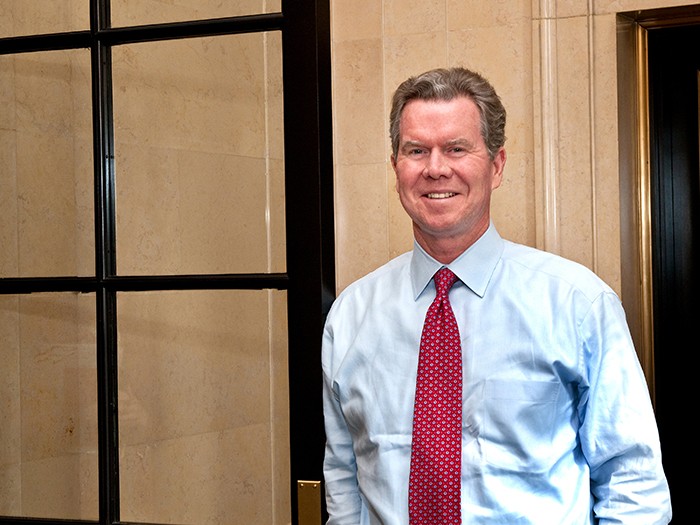Exclusive Memoir
In Memoriam: Liam McGee

Part One of an exclusive two-part memoir written before McGee’s untimely death in February.
In the wake of the Great Recession, it’s tempting to think that the surviving banks and other financial service companies have gotten a severe wake-up call.
Surely they’ve become very different companies now. They must have overhauled their controls and their strategies to prevent themselves from carrying so much risk in the future.
I’m hopeful that things have changed, but my own experiences have sobered me on this point. Organizational overhaul is possible, but it is difficult.
When I became CEO of The Hartford in October 2009, soon after the company nearly collapsed, I was struck by the organization’s resistance to major change. I didn’t find a sense of urgency.
We ultimately succeeded in restoring the company’s strength, and it is now well positioned for future growth. But it was much more challenging than I expected.
Good Intentions Gone Bad
Founded in 1810, The Hartford Financial Services Group was one of the largest property and casualty insurers in the United States in the 1990s. That’s when the managers in the company’s small life insurance business started offering variable annuities.
Let’s start with how The Hartford got in such a mess.
Their initial success in this new product category led to a major push, to the point where the company became an industry leader and a stock market darling. But as the annuity marketplace became crowded, the company tried to maintain its growth with riskier products and expansion to overseas markets, supported in turn by a riskier investment portfolio.
The financial crisis of 2008 brought this all to an end, and the stock price fell from $100 all the way to the low single digits. Only a $3.4 billion capital infusion from the federal government’s Troubled Asset Relief Program, coupled with $2.5 billion in crisis capital from the big European insurer Allianz, kept the company going.
From the outside, the turnaround of The Hartford might look pretty simple. In the short term, we got a lift from the recovery in the financial markets.
We also had a successful capital raise in March 2010. That allowed us to pay off TARP and gain breathing room to work on the underlying problem. (We paid off Allianz a year later.)
We then determined that the company’s balance sheet was simply not big enough to absorb the risk in the annuity business, so we stopped issuing new policies. The remaining life-related activities were not strong enough to survive on their own, so we sold those off to better-capitalized companies that specialized in those areas.
We refocused around our historic expertise in property and casualty insurance, which had languished during the run-up in annuities. The company is now in a solid capital position, with much better risk-management capabilities and a more collaborative senior executive team. It’s poised for sustained growth.
Rule of thumb: Financial services firms are just not equipped to handle revenues rising much faster than the rate of GDP growth.
Like other financial services companies that sank in 2008, however, the story is more complicated. Let’s start with how The Hartford got in such a mess.
It had lots of smart, talented people who understood risk. The people in variable annuities started off doing just what they were supposed to do: exploring opportunities. When the product became a hit, they understandably built up a process to ramp up sales domestically.
Then they went overseas, including a decision to enter Japan without hedging the currency risk. Executives in headquarters, delighted at the profitable growth, encouraged them, while investors cheered.
Prompted by The Hartford’s successes, competitors entered the markets and offered even riskier annuity products. It was the same story that played out elsewhere in the run-up to the financial crisis, with subprime lending, collateralized debt obligations and other financial innovations that got out of hand.
Soon, the company was growing faster than it could add infrastructure to support the added size. It didn’t keep up with risk management and technology platforms in the life business, because all the spare capital went directly into new annuity programs.
Rule of thumb: Financial services firms are just not equipped to handle revenues rising much faster than the rate of GDP growth.
The complexity was the biggest challenge, as The Hartford was suddenly a multi-line business, not a P&C-dominated company with a few smaller operations.
Each division was watching over its own risk in the narrow sense, but management did not develop a strong risk management function at the corporate level. It couldn’t aggregate the risks from the separate divisions.
Meanwhile the rapid growth in the company’s annuity and other life businesses meant that the company had to build up its investment portfolio quickly. It had a lot of liquidity to invest.
But the investment management division’s incentives were geared to maximize return, not to balance risk versus reward. The division lacked the tools to properly assess the risk it was taking or to see how it correlated to risks embedded in the annuity products that were being sold.
Like a sales force rewarded for gross revenue, not profitability, the managers didn’t fully factor risk into their investments. As a result, like many investors, they went after riskier assets, especially securities backed by commercial and residential real estate — right before the real estate market crashed.
The Hartford’s organization was inevitably influenced by the mood in financial services generally. People were dazzled by complex new packages of securities that managed risk in creative new ways. So the real estate bubble didn’t bother The Hartford’s executives as much as it should have. They tolerated more risk than they would have otherwise.
When one of your businesses is thriving, it’s hard for anyone at headquarters to tell it what to do.
Still, there were certainly smart people who understood that The Hartford had bitten off more than it could chew. In 2007, the company decided not to match competitors that were adding even riskier elements to their variable annuities. And well before the crash, some executives were urging the company to cease selling annuities or to sell the life business to a better-capitalized rival.
But decisions were deferred by leaders who understandably couldn’t give up on the money machine. When the company finally accepted the seriousness of the situation, the economy tanked.
It’s easy to blame headquarters for failing to assess risk at the corporate level. But you have to remember that throughout its history, The Hartford had had a fairly narrow product line.
When one of your businesses is growing fast, you want to put your resources first into supporting that business directly. That leaves less time and energy to put into setting up new resources at the corporate level. Assessing aggregate risk is a complex undertaking that requires sophisticated tools and staff.
It’s a political as well as a resource challenge. When one of your businesses is thriving, it’s hard for anyone at headquarters to tell it what to do. And traditionally, the business unit CFOs had much more power than their corporate counterpart, who was more of an adviser than a boss.
After all, even larger insurance companies had trouble understanding their risk as they diversified. When AIG got in trouble in 2008 because of its complex financial products, regulators struggled to capture the total risk and calculate how much capital the company needed to regain its footing.
For headquarters, allowing a successful product line to keep expanding is one kind of decision, a pretty easy one. But reining in that same product line because of risk on the corporate level is a much harder decision that inevitably invites pushback from the managers whose bonuses depend on the business.
Insurance involves long time horizons, so people like to deliberate and study a problem carefully. You can always find a relevant issue to justify a delay. Combine that with a headquarters staff less powerful than the businesses it’s supposed to oversee, and you inevitably end up with a kind of “states-rights” mentality that refrains from making tough calls.
Don’t Assume You Have a Burning Platform
Turnarounds may be tough, the thinking goes, but at least people will be open to changes. They know their company is in trouble, so you’ll get less of the political resistance you usually find when you push a major initiative.
That’s certainly what I thought. When I was offered the CEO position in September 2009, the company was in such bad shape that I almost didn’t accept.
Even with the TARP bailout to cover some of the toxic assets and buy some time, I worried that the unprofitable annuity policies, especially in Japan, would destroy the company’s insurance ratings and therefore its ability to compete.
The problems were so severe, and so clear to me from the outside, that I assumed the organization shared my anxiety. I had very little background in insurance, so I figured I got the job because the directors wanted a fresh start. At least I would have a burning platform.
Boy was I wrong. Many senior executives didn’t think things were so bad. They blamed the troubles on the deep recession coupled with some excesses in variable annuities. Now that they had the TARP and Allianz money, they figured they needed to make only incremental changes and just ride out the inevitable economic recovery.
After all, they had had such an impressive run of profitable growth until 2007. It was hard to give that up and fashion a new strategy. At a minimum, they argued, difficult decisions should be deferred to give the economy time to improve and rectify our situation.
The company’s siloed structure also kept people from seeing the big picture. Executives could focus on their individual product lines and customer bases, rather than the macro financials.
At the same time, the size of the overall company insulated them from threats in the marketplace. How could a big, 200-year-old institution like The Hartford really be in dire straits?
People weren’t outright opposed to changing the strategy. I found several plans filed away when I arrived. Almost every kind of move had been looked into. But I still remember those early meetings, where we would talk for hours about a change. And then people would want to go back and study the issue further. I wanted to move forward, but the organization didn’t share the same urgency.
Start Changing Everything
The first thing I did was to focus on the immediate challenge: boosting our capital levels in order to withstand the continuing volatility in the market. As an insurer, we had strict rules in place to protect policyholders. Once we were able to raise capital, in March 2010, I was eager to focus on the strategic issues.
We formulated a rough strategy as follows. We wanted to be in businesses with growth prospects, where we could invest and increase profits. But these businesses had to generate capital over time, not consume capital. And third, they had to lower the overall market volatility for the firm.
Which businesses should we sell, in what kind of package, and when? We needed to find a buyer at a good price. And how were we going to unload the Japan albatross?
By those standards, the life business didn’t make sense. The only way we could make the credible guarantees we needed for a competitive annuity business was through a much bigger boost in our capital ratios. That wasn’t going to happen.
The annuities really belonged in the hands of a scale player. As for individual life insurance and other products in the life division, we didn’t have a strong enough market position to expect much growth. The annuities really dominated the division.
Meanwhile, we still had a core competency in property and casualty. Parts of that business had atrophied because the company had put most of its available capital into the annuities business, but it was still performing reasonably well with a strong market position. It also came with ancillary businesses in employee benefits. So we formulated a clear strategy to return to the company’s historic focus on property and casualty.
I was eager to move forward, but we couldn’t, for two reasons. First, like most financial services companies in multiple businesses, the company’s position was so complex and market-dependent that the structure couldn’t change quickly.
Which businesses should we sell, in what kind of package, and when? We needed to find a buyer at a good price. And how were we going to unload the Japan albatross?
Second, I didn’t think the existing senior team was capable of such a major shift. They had just gotten too used to the old ways, and would have difficulty with major changes.
So we set the overall direction, but we couldn’t carry it out immediately. We were also hoping to get some short-term benefit from the “green shoots” of economic recovery that people were talking about in early 2010. Our mix of businesses wouldn’t work in the long term, but in the short term they could improve their numbers and get us a better purchase price down the road.
Meanwhile, I realized we needed to get to work overhauling the company’s culture. We needed to make the company more decisive, and make people think outside their own silos.
That latter point really came home to me when all the senior managers in the company got together to discuss the big issues. It seemed an obvious thing for a Fortune 100 company to do. But it turns out they never did.
When we held our first gathering of the top 50 or so executives, most of them didn’t understand the point of it all. Many had never met their counterparts in different business lines. “What did all of this corporate talk have to do with me?”
To get everyone focused on the whole company, we launched the “One Hartford” campaign. Executive bonuses got flipped around so people couldn’t get big payouts unless the company as a whole prospered. Division-level results still mattered, but the priorities were clear.
Without that foundation, people wouldn’t be willing to speak out on problems that affected The Hartford as a whole. We wouldn’t get the support we needed for carrying out the new strategy. We might still be able to restructure the company, but it would fall into the same kind of trap in the next recession.
We also developed significant risk management capabilities. The board established a risk committee composed of all the directors, and it convened at each quarterly board meeting. I established a chief risk officer position, reporting directly to me as CEO.
Working through an internal committee of all our senior leaders, the CRO, CFO and I established credit, market and other risk tolerances, and presented scorecards on each at every board meeting. We now understood the risks in each of our businesses and in our investment portfolio, and how those risks correlated.
Read Part Two here.











